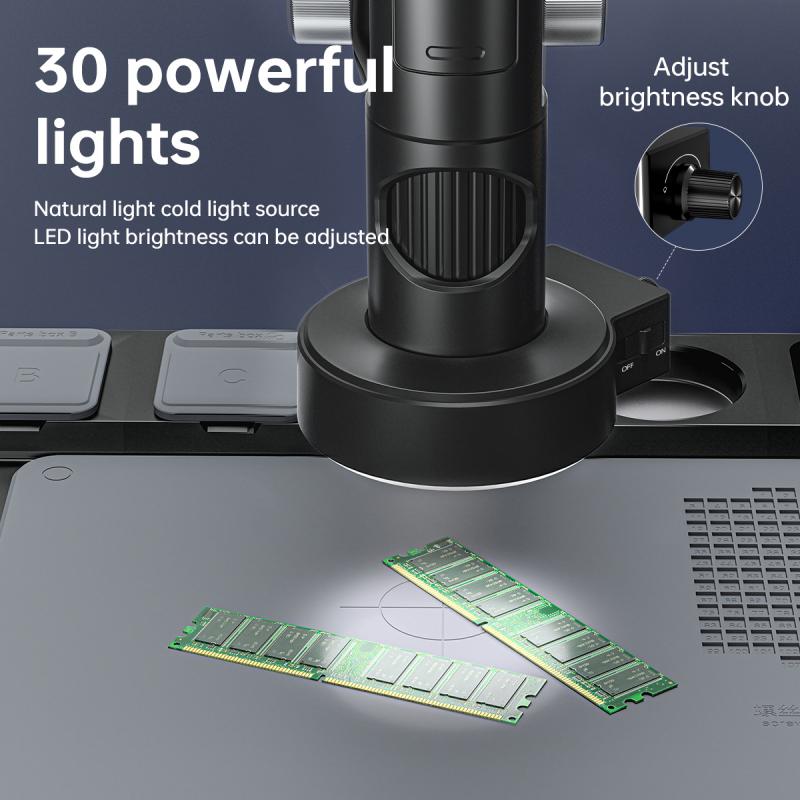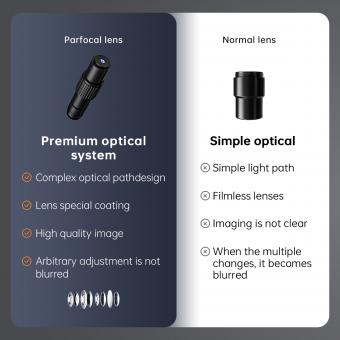How Do Electron Microscopes Help Scientists ?
Electron microscopes help scientists by providing high-resolution images of samples at the nanoscale. They use a beam of electrons instead of light to magnify and visualize the structure of objects. This allows scientists to study the fine details of various materials, such as cells, tissues, and even individual atoms. Electron microscopes enable researchers to observe the intricate structures and features of samples with much greater clarity and precision compared to traditional light microscopes. They have contributed significantly to advancements in fields like biology, materials science, nanotechnology, and medicine, providing valuable insights into the composition, behavior, and interactions of microscopic entities.
1、 High-resolution imaging of small-scale structures and particles.
Electron microscopes play a crucial role in scientific research by providing high-resolution imaging of small-scale structures and particles. These powerful instruments use a beam of electrons instead of light to magnify and visualize objects at a much higher resolution than traditional optical microscopes. This ability to see objects at the nanoscale level has revolutionized various fields of science, including biology, materials science, and nanotechnology.
One of the primary advantages of electron microscopes is their ability to reveal intricate details of biological specimens. By using electron microscopy, scientists can observe the ultrastructure of cells, visualize subcellular components, and study the interactions between molecules. This has led to significant advancements in our understanding of cellular processes, disease mechanisms, and the development of new drugs and therapies.
In materials science, electron microscopes enable researchers to examine the atomic and molecular structure of materials. This information is crucial for understanding the properties and behavior of materials, such as metals, ceramics, and polymers. By studying the microstructure of materials, scientists can design and engineer new materials with improved properties, leading to advancements in fields like aerospace, electronics, and energy storage.
Furthermore, electron microscopes have been instrumental in the field of nanotechnology. They allow scientists to visualize and manipulate nanoscale structures, such as nanoparticles and nanowires, with precision. This has paved the way for the development of nanomaterials with unique properties and applications, including in medicine, electronics, and environmental remediation.
The latest advancements in electron microscopy technology have further enhanced its capabilities. For instance, the development of aberration-corrected electron microscopes has significantly improved the resolution and image quality. Additionally, the integration of electron microscopy with other techniques, such as spectroscopy and tomography, allows scientists to obtain detailed chemical and three-dimensional information about samples.
In conclusion, electron microscopes are invaluable tools for scientists as they provide high-resolution imaging of small-scale structures and particles. Their ability to reveal intricate details has advanced our understanding of biology, materials science, and nanotechnology. With ongoing technological advancements, electron microscopy continues to push the boundaries of scientific research, enabling new discoveries and innovations.

2、 Detailed analysis of material composition and elemental mapping.
Electron microscopes play a crucial role in scientific research by providing scientists with a powerful tool for detailed analysis of material composition and elemental mapping. These microscopes use a beam of electrons instead of light to magnify and visualize samples, allowing for a much higher resolution and greater depth of field.
One of the primary advantages of electron microscopes is their ability to provide detailed information about the composition of materials. By analyzing the way electrons interact with the sample, scientists can determine the elemental composition and identify specific compounds present. This information is invaluable in various fields, such as materials science, geology, and biology, where understanding the composition of materials is essential for advancing knowledge and developing new technologies.
Furthermore, electron microscopes enable scientists to perform elemental mapping, which involves determining the distribution of different elements within a sample. By scanning the sample with a focused electron beam and detecting the resulting signals, scientists can create maps that show the spatial distribution of elements. This capability is particularly useful in studying complex materials, such as alloys or biological samples, where understanding the distribution of elements can provide insights into their properties and behavior.
In recent years, electron microscopes have undergone significant advancements, further enhancing their capabilities. For example, the development of scanning transmission electron microscopy (STEM) has allowed for even higher resolution imaging and improved elemental mapping. Additionally, the integration of energy-dispersive X-ray spectroscopy (EDS) detectors with electron microscopes has enabled simultaneous imaging and elemental analysis, providing a more comprehensive understanding of samples.
In conclusion, electron microscopes are indispensable tools for scientists due to their ability to provide detailed analysis of material composition and elemental mapping. With ongoing advancements, these microscopes continue to push the boundaries of scientific research, enabling new discoveries and advancements in various fields.

3、 Investigation of surface morphology and topography.
Electron microscopes play a crucial role in helping scientists investigate surface morphology and topography. These powerful instruments use a beam of electrons instead of light to magnify and visualize objects at a much higher resolution than traditional light microscopes. This allows scientists to study the fine details of various materials and biological specimens, providing valuable insights into their structure and composition.
One of the primary advantages of electron microscopes is their ability to achieve extremely high magnification levels. They can magnify objects up to a million times, revealing intricate details that would otherwise be invisible. This level of magnification enables scientists to study the surface morphology of materials, such as the arrangement of atoms and the presence of defects or irregularities. By understanding the surface morphology, scientists can gain insights into the material's properties, behavior, and potential applications.
Furthermore, electron microscopes provide valuable information about the topography of surfaces. They can generate three-dimensional images, allowing scientists to visualize the height variations and surface features of objects. This information is crucial in fields such as nanotechnology, where precise control over surface structures is essential for designing and developing advanced materials and devices.
In recent years, electron microscopes have also been used to investigate the surface chemistry of materials. By combining electron microscopy with spectroscopy techniques, scientists can analyze the elemental composition and chemical bonding of surfaces. This knowledge is vital for understanding the reactivity, catalytic properties, and surface interactions of materials, which has implications in fields such as materials science, chemistry, and environmental science.
Overall, electron microscopes have revolutionized the study of surface morphology and topography, providing scientists with a powerful tool to explore the nanoscale world. With ongoing advancements in electron microscopy technology, such as the development of aberration-corrected lenses and faster detectors, scientists can now obtain even higher resolution images and perform more detailed analyses. This continuous improvement in electron microscopy capabilities will undoubtedly lead to further breakthroughs in various scientific disciplines.

4、 Visualization of biological samples at nanoscale resolution.
Electron microscopes play a crucial role in helping scientists visualize biological samples at nanoscale resolution. These powerful instruments use a beam of electrons instead of light to magnify and image specimens, allowing researchers to observe structures and processes at an incredibly detailed level.
One of the primary advantages of electron microscopes is their ability to achieve much higher resolution than traditional light microscopes. While light microscopes are limited by the wavelength of visible light, electron microscopes can achieve resolutions down to the atomic level. This enables scientists to study the intricate details of cells, tissues, and even individual molecules.
By visualizing biological samples at nanoscale resolution, electron microscopes provide valuable insights into the structure and function of various biological systems. They allow scientists to observe the fine details of cellular organelles, such as mitochondria, endoplasmic reticulum, and Golgi apparatus, which are crucial for understanding cellular processes.
Moreover, electron microscopes are instrumental in studying the ultrastructure of viruses, bacteria, and other microorganisms. They help identify the specific features and mechanisms that enable these pathogens to infect and interact with host cells, aiding in the development of targeted treatments and vaccines.
In recent years, electron microscopy techniques have advanced further, allowing scientists to not only visualize but also analyze biological samples. Advanced imaging techniques, such as cryo-electron microscopy, enable the visualization of biomolecules in their native state, providing valuable insights into their three-dimensional structure and function. This has revolutionized the field of structural biology, leading to breakthroughs in drug discovery and the development of new therapies.
In conclusion, electron microscopes are indispensable tools for scientists as they enable the visualization of biological samples at nanoscale resolution. By providing detailed insights into cellular structures and processes, electron microscopy has significantly contributed to our understanding of biology and has the potential to drive further advancements in various fields, including medicine and biotechnology.



































